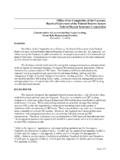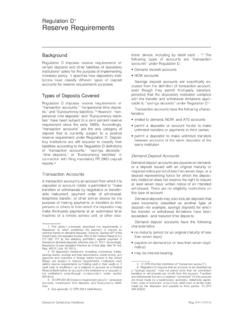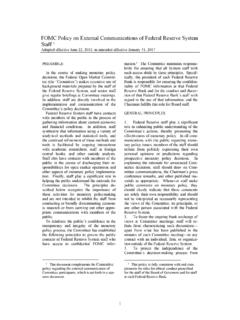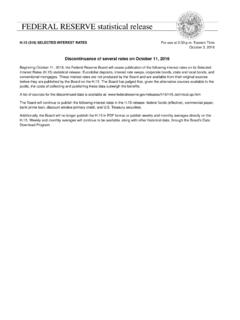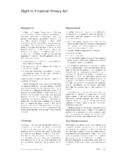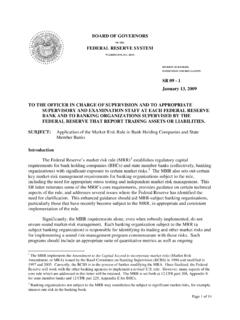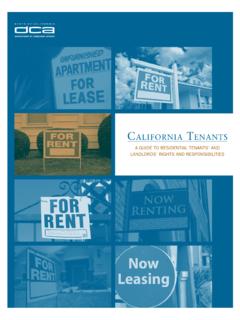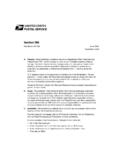Transcription of Consumer Handbook on Adjustable Rate Mortgages (ARM)
1 Consumer Handbook on Adjustable Rate Mortgages (ARM) | 1 The Federal Reserve Board and the Office of Thrift Supervi-sion prepared this booklet on Adjustable -rate Mortgages (ARMs) in response to a request from the House Com mittee on Banking, Finance and Urban Affairs (currently, the Commit-tee on Financial Services) and in consultation with many other agencies and trade and con-sumer groups. It is designed to help consumers understand an important and complex mort-gage option available to believe a fully informed Consumer is in the best position to make a sound economic choice. If you are buying a home and look-ing for a home loan, this booklet will provide useful basic information about ARMs. It cannot provide all the answers you will need, but we believe it is a good starting 16/20/2005 9:35:44 AM6/20/2005 9:35:44 AM2 | Consumer Handbook on Adjustable Rate Mortgages (ARM)People are asking.
2 Some newspaper ads for home loans show surprisingly low rates . Are these loans for real, or is there a catch? Some of the ads you see are for Adjustable rate Mortgages (ARMs). These loans may have low rates for a short time maybe only for the first year. After that, the rates may be adjusted on a regular basis. This means that the interest rate and the amount of the monthly payment may go up or down. Will I know in advance how much my payment may go up? With an Adjustable -rate mortgage , your future monthly payment is uncertain. Some types of ARMs put a ceiling on your pay ment increase or interest-rate increase from one period to the next. Virtually all types must put a ceiling on rate increases over the life of the loan. Is an ARM the right type of loan for me? That depends on your financial situation and the terms of the ARM. ARMs carry risks in periods of rising interest rates , but they can be cheaper over a longer term if inter est rates decline.
3 You will be able to answer the question better once you under-stand more about ARMs. This booklet should 26/20/2005 9:35:49 AM6/20/2005 9:35:49 AMConsumer Handbook on Adjustable Rate Mortgages (ARM) | 3 Mortgages have changed, and so have the questions that con-sumers need to ask and have answered. Shopping for a mortgage used to be a relatively simple process. Most home mort gage loans had interest rates that did not change over the life of the loan. Choosing among these fixed-rate mort-gage loans meant comparing interest rates , monthly payments, fees, prepayment penalties, and due-on-sale clauses. Today, many loans have interest rates (and monthly payments) that can change from time to time. To compare one ARM with another or with a fixed-rate mortgage , you need to know about indexes, margins, discounts, caps, negative amortization, and convertibility.
4 You need to consider the maximum amount your monthly payment could increase. Most important, you need to compare what might happen to your mort gage costs with your future ability to pay. This booklet explains how ARMs work and some of the risks and advantages to borrowers that ARMs introduce. It discusses features that can help reduce the risks and gives some pointers about advertising and other ways you can get information from lenders. Important ARM terms are defined in a glossary on page 19. And a checklist at the end of the booklet should help you ask lenders the right questions and figure out whether an ARM is right for you. Asking lenders to fill out the checklist is a good way to get the information you need to compare 36/20/2005 9:35:49 AM6/20/2005 9:35:49 AM4 | Consumer Handbook on Adjustable Rate Mortgages (ARM)What is an ARM?
5 With a fixed-rate mortgage , the interest rate stays the same during the life of the loan. But with an ARM, the interest rate changes periodically, usually in relation to an index, and pay-ments may go up or down accordingly. Lenders generally charge lower initial interest rates for ARMs than for fixed-rate Mortgages . This makes the ARM easier on your pocketbook at first than a fixed-rate mortgage for the same amount. It also means that you might qualify for a larger loan because lenders sometimes make the decision about whether to extend a loan on the basis of your current income and the first year s payments. Moreover, your ARM could be less expen sive over a long period than a fixed-rate mortgage for example, if interest rates remain steady or move lower. Against these advantages, you have to weigh the risk that an increase in interest rates would lead to higher monthly pay-ments in the future.
6 It s a trade-off you get a lower rate with an ARM in exchange for assuming more risk. Here are some questions you need to consider: Is my income likely to rise enough to cover higher mortgage payments if interest rates go up? Will I be taking on other sizable debts, such as a loan for a car or school tuition, in the near future? How long do I plan to own this home? (If you plan to sell soon, rising interest rates may not pose the problem they do if you plan to own the house for a long time.) Can my payments increase even if in terest rates generally do not increase? 46/20/2005 9:35:49 AM6/20/2005 9:35:49 AMConsumer Handbook on Adjustable Rate Mortgages (ARM) | 5 How ARMs Work:the Basic FeaturesThe adjustment period With most ARMs, the interest rate and monthly payment change every year, every three years, or every five years.
7 However, some ARMs have more frequent rate and payment changes. The period between one rate change and the next is called the adjustment period. A loan with an adjustment period of one year is called a one-year ARM, and the interest rate can change once every index Most lenders tie ARM interest-rate changes to changes in an index rate. These in dexes usually go up and down with the general movement of interest rates . If the index rate moves up, so does your mortgage rate in most circumstances, and you will probably have to make higher monthly payments. On the other hand, if the index rate goes down, your monthly payment may go down. Lenders base ARM rates on a variety of indexes. Among the most common indexes are the rates on one-, three-, or five-year Treasury securities. Another common index is the national or regional average cost of funds to savings and loan associations.
8 A few lenders use their own cost of funds as an index, which gives them more control than using other indexes. You should ask what index will be used and how often it changes. Also ask how it has fluctuated in the past and where it is 56/20/2005 9:35:49 AM6/20/2005 9:35:49 AM6 | Consumer Handbook on Adjustable Rate Mortgages (ARM)The margin To determine the interest rate on an ARM, lenders add to the index rate a few percent age points, called the margin. The amount of the margin may differ from one lender to another, but it is usually constant over the life of the rate + margin =ARM interest rate Let s say, for example, that you are com paring ARMs offered by two different lenders. Both ARMs are for 30 years and have a loan amount of $65,000. (All the examples used in this booklet are based on this amount for a 30-year term.)
9 Note that the pay-ment amounts shown here do not include taxes, insurance, or similar items.) Both lenders use the rate on one-year Treasury securities as the index. But the first lender uses a 2% mar gin, and the second lender uses a 3% mar gin. Here is how that difference in the margin would affect your initial monthly payment. In comparing ARMs, look at both the index and margin for each program. Some indexes have higher values, but they are usually used with lower margins. Be sure to discuss the margin with your 66/20/2005 9:35:49 AM6/20/2005 9:35:49 AMConsumer Handbook on Adjustable Rate Mortgages (ARM) | 7 Home sale price $ 85,000 Less down payment - 20,000 mortgage amount $ 65,000 mortgage term 30 yearsFIRST LENDEROne-year index = 8%Margin = 2%ARM interest rate = 10%Monthly payment @ 10 % = $ LENDEROne-year index = 8%Margin = 3%ARM interest rate = 11%Monthly payment @ 11% = $ 76/20/2005 9:35:49 AM6/20/2005 9:35:49 AM8 | Consumer Handbook on Adjustable Rate Mortgages (ARM) Consumer Cautions Discounts Some lenders offer initial ARM rates that are lower than their standard ARM rates (that is, lower than the sum of the index and the margin).
10 Such rates , called discounted rates , are often combined with large initial loan fees ( points ) and with much higher rates after the discount expires. Very large discounts are often arranged by the seller. The seller pays an amount to the lender so that the lender can give you a lower rate and lower payments early in the mortgage term. This arrangement is re ferred to as a seller buydown. The seller may increase the sales price of the home to cover the cost of the buy-down. A lender may use a low initial rate to de cide whether to approve your loan, based on your ability to afford it. You should be care-ful to consider whether you will be able to afford payments in later years when the discount expires and the rate is adjusted. Here is how a discount might work. Let s assume that the lend-er s standard one-year ARM rate (index rate plus margin) is currently 10%.
